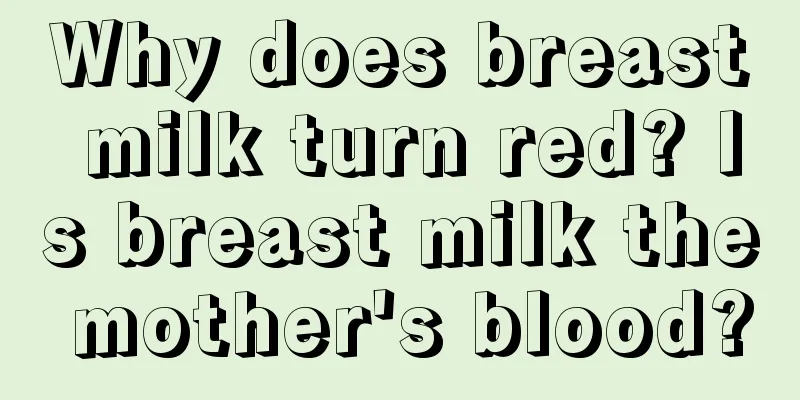Why does breast milk turn red? Is breast milk the mother's blood?

|
Many people have found that expressed breast milk may turn red after being left for a while. Some mothers even express red breast milk. What is going on? Some people say that breast milk is the mother's blood. Is this true? Why does breast milk turn red?Part of it is due to inflammation in the mother's body, and part of it is due to microbial infection. 1. Breast milk contains all the nutrients and antibodies that babies need to grow, and the formation of breast milk is also a magical process. After the various foods eaten by the mother are digested in the gastrointestinal tract, the blood transports the nutrients to various parts of the body. Some of them are transported to the breasts, and then absorbed by the mammary gland cells to form milk. Milk is the result of the combined action of prolactin and the lactation reflex. Blood only plays a "transportation" role, and milk is not transformed from blood! 2. Simply put, blood mainly serves as a transporter, and the mammary gland is a processing plant. However, during this transportation process, the blood itself does not enter the breast milk, and breast milk does not contain blood cells or hemoglobin, so breast milk is not blood, but the relationship between the two is inseparable. 3. Many ingredients in breast milk come from nutrients in the blood. There is a blood vessel wall between the blood and the mammary gland, which prevents the blood from entering the mammary gland and directly contacting the milk. However, this barrier is not unbreakable. If the layers of cells between the capillaries and the alveoli are damaged, the blood can enter the breast milk and cause blood milk. 4. In addition to direct blood intrusion, it is also possible that the milk turns red, similar to blood, due to the fermentation of microorganisms. Because many products of microbial metabolism are red, if they are allowed to multiply, the milk will turn red after a long time, giving people the illusion that the milk is blood. Is breast milk the mother's blood?This strange-sounding story has been circulating on the Internet for a long time. The story versions are similar: put breast milk in a glass bottle and seal it for a few years, and the originally milky white breast milk turns into a bottle of red liquid. From a scientific point of view, is this true? Tu Xinzhi, deputy chief physician of the Department of Obstetrics and Gynecology at Shenzhen Maternal and Child Health Hospital affiliated to Southern Medical University, said that in terms of composition, both blood and breast milk contain protein and fat, but breast milk does not contain red blood cells or hemoglobin, and the two are not the same substance. The red color of blood mainly comes from the hemoglobin heme in red blood cells; while breast milk is the mammary gland differentiated from sweat glands, and is stimulated by estrogen and progesterone during pregnancy, and the various proteins and nutrients synthesized by mammary gland cells under the constant stimulation of prolactin secreted by the pituitary gland. The main components of protein contained in breast milk are casein and whey protein, and there are no enzymes required for red blood cell metabolism. Without the participation of enzymes, breast milk cannot produce a catalytic reaction to become blood even if it is stored for decades. Under normal circumstances, red blood cells in the blood cannot pass through the blood vessel walls to reach the mammary gland. It is only during the process of milk secretion that blood passes through arteries and capillaries to bring oxygen and nutrients needed for metabolism to the mammary gland. Therefore, blood and milk are not the same substance at all, just like employees of two companies working in the same office building, who have never met directly, have no common problems, and no problem of who becomes who. So why does the sealed milk turn red? Tu Xinzhi introduced that it is likely that the milk that has been left for a long time is caused by microorganisms. The metabolic products of some microorganisms are red. If such microorganisms contaminate the milk and reproduce successfully in the milk, the long-standing milk may turn red. Another condition is hemo-milk. If the layers of cells between the capillaries and the alveoli are damaged and blood enters the breast milk, it will cause hemo-milk. Generally, after excluding the possibility of breast and body diseases, it is common that the breast capillaries expand too much due to the increase of hormones in pregnancy, or the rupture of a part of the capillaries due to the accumulation of milk for too long, making the breast milk bloody. In addition, it is not uncommon for patients with intraductal papilloma to have hemo-milk. However, this situation is an abnormality of milk secretion, and it does not mean that "milk is blood". It can be seen that whether breast milk turns red due to long-term storage or contamination by microorganisms, or there is abnormal milk blood, it does not mean that breast milk is equivalent to blood. The rumor that "breast milk is blood" is self-defeating. These reasons can also make breast milk redIn fact, in addition to beets, other foods known to affect the color of breast milk include carrots, pumpkins, green vegetables, and dragon fruit. Even medication for illness can cause breast milk to change color. However, not all "pink breast milk" is caused by food. Bacteria in the bottle can also cause breast milk to deteriorate. Keeping the bottle clean can prevent the baby from drinking milk contaminated by bacteria. Five things to know about diet for breastfeeding mothers1. Increase the intake of fish, poultry, eggs, lean meat and seafood. It is necessary to ensure that the mother takes in enough high-quality protein. If the protein is insufficient, the quality and quantity of breast milk will be affected. Animal foods such as fish, poultry, eggs, lean meat, etc. can provide rich high-quality protein. The mother should increase the total amount of fish, poultry, eggs, and lean meat by 100g-150g per day. 2. Increase the intake of milk and drink more soup. Mothers should increase their intake of calcium-rich foods such as milk. Milk is high in calcium and easy to absorb and utilize, and is the best food source of calcium. If a mother drinks 500ml of milk every day, she can get about 600mg of high-quality calcium. Milk and its products are rich in calcium, which can prevent osteoporosis and infant rickets. Mothers should also drink more soup and take in sufficient micronutrients to ensure the nutrient content of breast milk. 3. Food should be cooked lightly and with less oil, while ensuring calories. During the confinement period, you will spend more time in bed resting, so the food should be high in protein and low in fat, such as black fish, crucian carp, shrimp, eel, pigeon, to avoid obesity caused by excessive fat intake. In order to make the food easier to digest, steaming, stewing, braising and boiling are often used in cooking, and frying and deep-frying are not used. Some mothers start dieting during the confinement period in order to quickly restore their figure after giving birth. This is wrong, because if the calorie intake is insufficient, it will affect the mother's milk secretion, and the baby's "ration" will not be guaranteed, which will affect the baby's growth and development. 4. Eat both meat and vegetables, and a combination of coarse and fine foods The nutrients contained in each food are different. Bad eating habits such as picky eating and partial eating should be changed during the confinement period. The daily food variety should be rich, and meat and vegetables should be eaten together. Eating coarse grains and whole grains regularly is good for improving constipation. Bamboo shoots, spinach, and amaranth contain phytic acid, which will affect the absorption of trace elements such as calcium, iron, and zinc; oatmeal, malt, and barley tea can easily cause parturients to stop breastfeeding, so they should be avoided during the confinement period and throughout the lactation period. Animal offal is rich in iron, which can prevent anemia; red meat and shellfish are rich in zinc, which is also good for the intellectual development of children. These nutrients can be passed to babies through breast milk. Various beneficial foods should be eaten during the confinement period and throughout the lactation period. 5. Scientific activities and exercise to maintain a healthy weight In addition to paying attention to a proper diet, breastfeeding mothers should also exercise appropriately and do postpartum aerobics, which can promote postpartum body recovery and maintain a healthy weight. Regular physical activity and exercise of a certain intensity during breastfeeding will not affect the effect of breastfeeding. |
<<: What is the use of nebulization for babies? How many times a day can babies be nebulized?
Recommend
Which country's brand is Safeguard? Is Safeguard soap good?
Soap is actually used in daily life. It can be us...
What is the best day to give birth in June 2017? What is the best day to give birth in June 2017?
A newborn is the hope of a family. All parents ho...
What should you pay attention to during the confinement period after a caesarean section? Protecting the wound is the key
Different people choose different delivery method...
Can teachers see students during online classes? What are the benefits of online classes?
Everyone must have heard of many ways of taking c...
How to help your baby transition smoothly from bottle to cup
It is very common for babies to drink milk from b...
Is there any relationship between a baby's speech early or late and intelligence? What should I do if my baby speaks late?
Generally speaking, babies can speak some simple ...
How to clean the yellowed baby bottle? Can I still use the yellowed baby bottle?
The milk bottle plays a very important role in th...
How many carnations should be given on Teacher's Day? What color carnations should be given on Teacher's Day?
How many carnations should be given on Teachers&#...
Can pregnant women eat yam porridge? What should pregnant women pay attention to when eating yam porridge?
Everyone should have heard of a lot of food in li...
Is it normal to have one menstrual period and then no menstrual period during breastfeeding? How many menstrual periods will I have during breastfeeding?
Is it normal to have one menstruation and then no...
What are the benefits of parents cultivating empathy in their children?
When educating young children, many aspects need ...
What is a good name for a boy? What is a meaningful name for a boy?
Everyone's name represents the hopes and bles...
Where are Philips electric toothbrushes produced? What batteries do Philips electric toothbrushes use?
Philips is a very popular brand. Where are Philip...
Can babies eat cantaloupe? Can babies eat cantaloupe?
Can babies eat cantaloupe? Cantaloupe is a fruit ...
How to do newborn hearing screening and what are the indicators
Newborn hearing is very important. Babies can und...









